Ran Cheng
LIG, SIGMA
A Systematic Survey on Large Language Models for Evolutionary Optimization: From Modeling to Solving
Sep 10, 2025Abstract:Large Language Models (LLMs), with their strong understanding and reasoning capabilities, are increasingly being explored for tackling optimization problems, especially in synergy with evolutionary computation. Despite rapid progress, however, the field still lacks a unified synthesis and a systematic taxonomy. This survey addresses this gap by providing a comprehensive review of recent developments and organizing them within a structured framework. We classify existing research into two main stages: LLMs for optimization modeling and LLMs for optimization solving. The latter is further divided into three paradigms according to the role of LLMs in the optimization workflow: LLMs as stand-alone optimizers, low-level LLMs embedded within optimization algorithms, and high-level LLMs for algorithm selection and generation. For each category, we analyze representative methods, distill technical challenges, and examine their interplay with traditional approaches. We also review interdisciplinary applications spanning the natural sciences, engineering, and machine learning. By contrasting LLM-driven and conventional methods, we highlight key limitations and research gaps, and point toward future directions for developing self-evolving agentic ecosystems for optimization. An up-to-date collection of related literature is maintained at https://github.com/ishmael233/LLM4OPT.
Diversity-Aware Policy Optimization for Large Language Model Reasoning
May 29, 2025Abstract:The reasoning capabilities of large language models (LLMs) have advanced rapidly, particularly following the release of DeepSeek R1, which has inspired a surge of research into data quality and reinforcement learning (RL) algorithms. Despite the pivotal role diversity plays in RL, its influence on LLM reasoning remains largely underexplored. To bridge this gap, this work presents a systematic investigation into the impact of diversity in RL-based training for LLM reasoning, and proposes a novel diversity-aware policy optimization method. Across evaluations on 12 LLMs, we observe a strong positive correlation between the solution diversity and Potential at k (a novel metric quantifying an LLM's reasoning potential) in high-performing models. This finding motivates our method to explicitly promote diversity during RL training. Specifically, we design a token-level diversity and reformulate it into a practical objective, then we selectively apply it to positive samples. Integrated into the R1-zero training framework, our method achieves a 3.5 percent average improvement across four mathematical reasoning benchmarks, while generating more diverse and robust solutions.
MetaBox-v2: A Unified Benchmark Platform for Meta-Black-Box Optimization
May 23, 2025Abstract:Meta-Black-Box Optimization (MetaBBO) streamlines the automation of optimization algorithm design through meta-learning. It typically employs a bi-level structure: the meta-level policy undergoes meta-training to reduce the manual effort required in developing algorithms for low-level optimization tasks. The original MetaBox (2023) provided the first open-source framework for reinforcement learning-based single-objective MetaBBO. However, its relatively narrow scope no longer keep pace with the swift advancement in this field. In this paper, we introduce MetaBox-v2 (https://github.com/MetaEvo/MetaBox) as a milestone upgrade with four novel features: 1) a unified architecture supporting RL, evolutionary, and gradient-based approaches, by which we reproduce 23 up-to-date baselines; 2) efficient parallelization schemes, which reduce the training/testing time by 10-40x; 3) a comprehensive benchmark suite of 18 synthetic/realistic tasks (1900+ instances) spanning single-objective, multi-objective, multi-model, and multi-task optimization scenarios; 4) plentiful and extensible interfaces for custom analysis/visualization and integrating to external optimization tools/benchmarks. To show the utility of MetaBox-v2, we carry out a systematic case study that evaluates the built-in baselines in terms of the optimization performance, generalization ability and learning efficiency. Valuable insights are concluded from thorough and detailed analysis for practitioners and those new to the field.
TensorNEAT: A GPU-accelerated Library for NeuroEvolution of Augmenting Topologies
Apr 11, 2025Abstract:The NeuroEvolution of Augmenting Topologies (NEAT) algorithm has received considerable recognition in the field of neuroevolution. Its effectiveness is derived from initiating with simple networks and incrementally evolving both their topologies and weights. Although its capability across various challenges is evident, the algorithm's computational efficiency remains an impediment, limiting its scalability potential. To address these limitations, this paper introduces TensorNEAT, a GPU-accelerated library that applies tensorization to the NEAT algorithm. Tensorization reformulates NEAT's diverse network topologies and operations into uniformly shaped tensors, enabling efficient parallel execution across entire populations. TensorNEAT is built upon JAX, leveraging automatic function vectorization and hardware acceleration to significantly enhance computational efficiency. In addition to NEAT, the library supports variants such as CPPN and HyperNEAT, and integrates with benchmark environments like Gym, Brax, and gymnax. Experimental evaluations across various robotic control environments in Brax demonstrate that TensorNEAT delivers up to 500x speedups compared to existing implementations, such as NEAT-Python. The source code for TensorNEAT is publicly available at: https://github.com/EMI-Group/tensorneat.
GPU-accelerated Evolutionary Many-objective Optimization Using Tensorized NSGA-III
Apr 08, 2025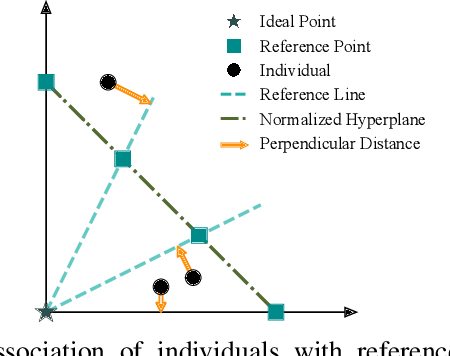
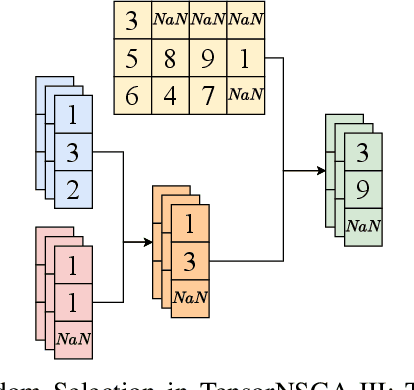

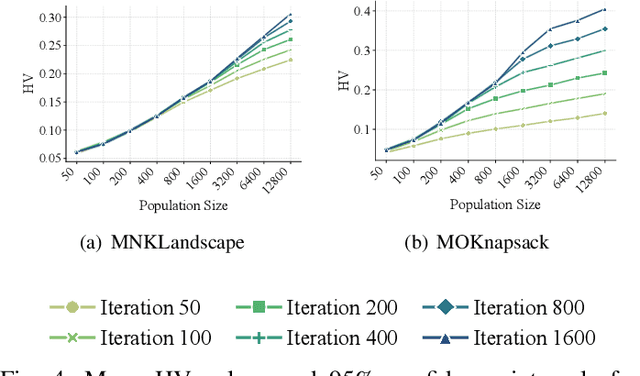
Abstract:NSGA-III is one of the most widely adopted algorithms for tackling many-objective optimization problems. However, its CPU-based design severely limits scalability and computational efficiency. To address the limitations, we propose {TensorNSGA-III}, a fully tensorized implementation of NSGA-III that leverages GPU parallelism for large-scale many-objective optimization. Unlike conventional GPU-accelerated evolutionary algorithms that rely on heuristic approximations to improve efficiency, TensorNSGA-III maintains the exact selection and variation mechanisms of NSGA-III while achieving significant acceleration. By reformulating the selection process with tensorized data structures and an optimized caching strategy, our approach effectively eliminates computational bottlenecks inherent in traditional CPU-based and na\"ive GPU implementations. Experimental results on widely used numerical benchmarks show that TensorNSGA-III achieves speedups of up to $3629\times$ over the CPU version of NSGA-III. Additionally, we validate its effectiveness in multiobjective robotic control tasks, where it discovers diverse and high-quality behavioral solutions. Furthermore, we investigate the critical role of large population sizes in many-objective optimization and demonstrate the scalability of TensorNSGA-III in such scenarios. The source code is available at https://github.com/EMI-Group/evomo
Bridging Evolutionary Multiobjective Optimization and GPU Acceleration via Tensorization
Mar 27, 2025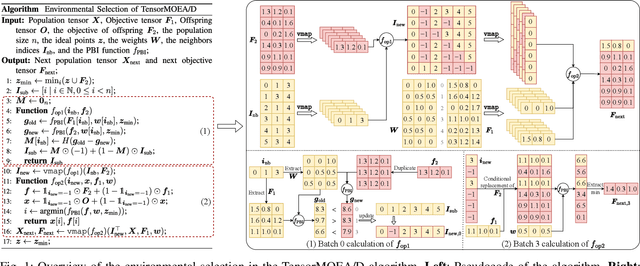
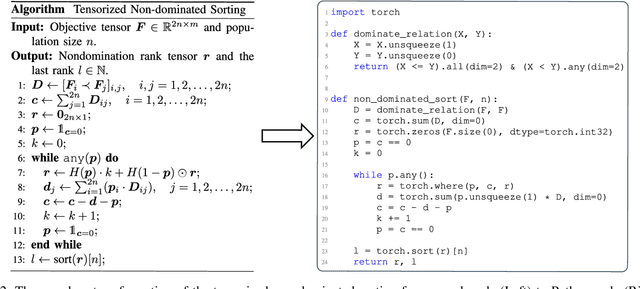
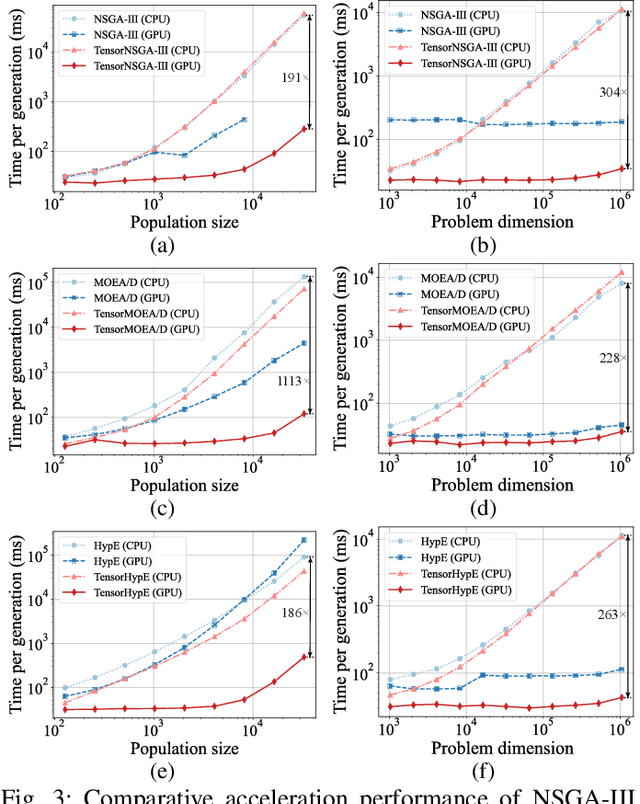
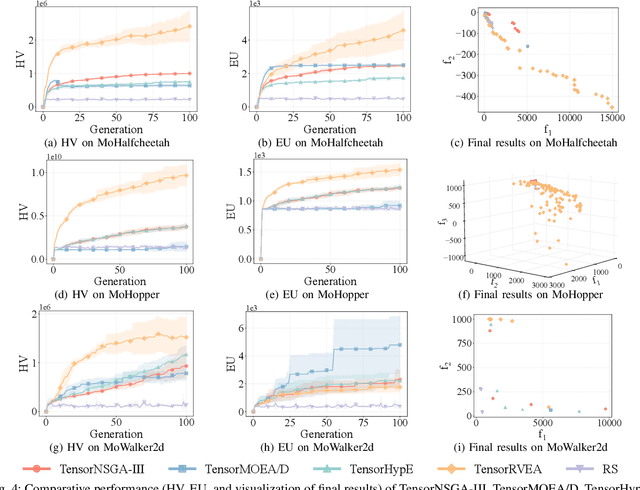
Abstract:Evolutionary multiobjective optimization (EMO) has made significant strides over the past two decades. However, as problem scales and complexities increase, traditional EMO algorithms face substantial performance limitations due to insufficient parallelism and scalability. While most work has focused on algorithm design to address these challenges, little attention has been given to hardware acceleration, thereby leaving a clear gap between EMO algorithms and advanced computing devices, such as GPUs. To bridge the gap, we propose to parallelize EMO algorithms on GPUs via the tensorization methodology. By employing tensorization, the data structures and operations of EMO algorithms are transformed into concise tensor representations, which seamlessly enables automatic utilization of GPU computing. We demonstrate the effectiveness of our approach by applying it to three representative EMO algorithms: NSGA-III, MOEA/D, and HypE. To comprehensively assess our methodology, we introduce a multiobjective robot control benchmark using a GPU-accelerated physics engine. Our experiments show that the tensorized EMO algorithms achieve speedups of up to 1113x compared to their CPU-based counterparts, while maintaining solution quality and effectively scaling population sizes to hundreds of thousands. Furthermore, the tensorized EMO algorithms efficiently tackle complex multiobjective robot control tasks, producing high-quality solutions with diverse behaviors. Source codes are available at https://github.com/EMI-Group/evomo.
ChatVLA: Unified Multimodal Understanding and Robot Control with Vision-Language-Action Model
Feb 21, 2025Abstract:Humans possess a unified cognitive ability to perceive, comprehend, and interact with the physical world. Why can't large language models replicate this holistic understanding? Through a systematic analysis of existing training paradigms in vision-language-action models (VLA), we identify two key challenges: spurious forgetting, where robot training overwrites crucial visual-text alignments, and task interference, where competing control and understanding tasks degrade performance when trained jointly. To overcome these limitations, we propose ChatVLA, a novel framework featuring Phased Alignment Training, which incrementally integrates multimodal data after initial control mastery, and a Mixture-of-Experts architecture to minimize task interference. ChatVLA demonstrates competitive performance on visual question-answering datasets and significantly surpasses state-of-the-art vision-language-action (VLA) methods on multimodal understanding benchmarks. Notably, it achieves a six times higher performance on MMMU and scores 47.2% on MMStar with a more parameter-efficient design than ECoT. Furthermore, ChatVLA demonstrates superior performance on 25 real-world robot manipulation tasks compared to existing VLA methods like OpenVLA. Our findings highlight the potential of our unified framework for achieving both robust multimodal understanding and effective robot control.
EvoRL: A GPU-accelerated Framework for Evolutionary Reinforcement Learning
Jan 25, 2025Abstract:Evolutionary Reinforcement Learning (EvoRL) has emerged as a promising approach to overcoming the limitations of traditional reinforcement learning (RL) by integrating the Evolutionary Computation (EC) paradigm with RL. However, the population-based nature of EC significantly increases computational costs, thereby restricting the exploration of algorithmic design choices and scalability in large-scale settings. To address this challenge, we introduce $\texttt{$\textbf{EvoRL}$}$, the first end-to-end EvoRL framework optimized for GPU acceleration. The framework executes the entire training pipeline on accelerators, including environment simulations and EC processes, leveraging hierarchical parallelism through vectorization and compilation techniques to achieve superior speed and scalability. This design enables the efficient training of large populations on a single machine. In addition to its performance-oriented design, $\texttt{$\textbf{EvoRL}$}$ offers a comprehensive platform for EvoRL research, encompassing implementations of traditional RL algorithms (e.g., A2C, PPO, DDPG, TD3, SAC), Evolutionary Algorithms (e.g., CMA-ES, OpenES, ARS), and hybrid EvoRL paradigms such as Evolutionary-guided RL (e.g., ERL, CEM-RL) and Population-Based AutoRL (e.g., PBT). The framework's modular architecture and user-friendly interface allow researchers to seamlessly integrate new components, customize algorithms, and conduct fair benchmarking and ablation studies. The project is open-source and available at: https://github.com/EMI-Group/evorl.
ParetoLens: A Visual Analytics Framework for Exploring Solution Sets of Multi-objective Evolutionary Algorithms
Jan 06, 2025Abstract:In the domain of multi-objective optimization, evolutionary algorithms are distinguished by their capability to generate a diverse population of solutions that navigate the trade-offs inherent among competing objectives. This has catalyzed the ascension of evolutionary multi-objective optimization (EMO) as a prevalent approach. Despite the effectiveness of the EMO paradigm, the analysis of resultant solution sets presents considerable challenges. This is primarily attributed to the high-dimensional nature of the data and the constraints imposed by static visualization methods, which frequently culminate in visual clutter and impede interactive exploratory analysis. To address these challenges, this paper introduces ParetoLens, a visual analytics framework specifically tailored to enhance the inspection and exploration of solution sets derived from the multi-objective evolutionary algorithms. Utilizing a modularized, algorithm-agnostic design, ParetoLens enables a detailed inspection of solution distributions in both decision and objective spaces through a suite of interactive visual representations. This approach not only mitigates the issues associated with static visualizations but also supports a more nuanced and flexible analysis process. The usability of the framework is evaluated through case studies and expert interviews, demonstrating its potential to uncover complex patterns and facilitate a deeper understanding of multi-objective optimization solution sets. A demo website of ParetoLens is available at https://dva-lab.org/paretolens/.
Improving Vision-Language-Action Models via Chain-of-Affordance
Dec 29, 2024



Abstract:Robot foundation models, particularly Vision-Language-Action (VLA) models, have garnered significant attention for their ability to enhance robot policy learning, greatly improving robot generalization and robustness. OpenAI recent model, o1, showcased impressive capabilities in solving complex problems by utilizing extensive reasoning chains. This prompts an important question: can robot models achieve better performance in multi-task, complex environments by reviewing prior observations and then providing task-specific reasoning to guide action prediction? In this paper, we introduce \textbf{Chain-of-Affordance (CoA)}, a novel approach to scaling robot models by incorporating reasoning in the format of sequential robot affordances to facilitate task completion. Specifically, we prompt the model to consider the following four types of affordances before taking action: a) object affordance - what object to manipulate and where it is; b) grasp affordance - the specific object part to grasp; c) spatial affordance - the optimal space to place the object; and d) movement affordance - the collision-free path for movement. By integrating this knowledge into the policy model, the robot gains essential context, allowing it to act with increased precision and robustness during inference. Our experiments demonstrate that CoA achieves superior performance than state-of-the-art robot foundation models, such as OpenVLA and Octo. Additionally, CoA shows strong generalization to unseen object poses, identifies free space, and avoids obstacles in novel environments.
 Add to Chrome
Add to Chrome Add to Firefox
Add to Firefox Add to Edge
Add to Edge